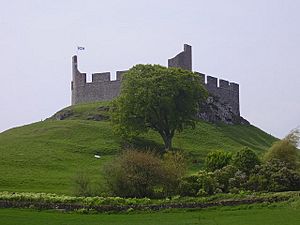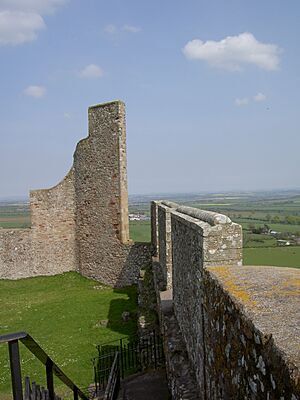Hume Castle facts for kids
Quick facts for kids Hume Castle |
|
|---|---|
| Middle English: Home Castle | |
| Hume, Berwickshire, Scotland | |
 |
|
| Coordinates | 55°39′55″N 2°28′15″W / 55.66528°N 2.47083°W |
| Type | Castle of enceinte, recreated as a folly |
| Site information | |
| Owner | Clan Home Association / Historic Scotland |
| Open to the public |
Yes |
| Condition | Ruined, rebuilt as folly |
| Site history | |
| Built | 12th/13th century |
| Built by | William de Home |
| Materials | Stone |
| Demolished | 1650 |
Hume Castle is an old castle in Berwickshire, Scotland. It was built in the late 1100s or early 1200s. The powerful Home family, who were important leaders in the Scottish Borders, owned it. They were known as the Lords Home and later the Earls of Home. The castle is near the village of Hume, between Greenlaw and Kelso.
The castle stands on a high hill. From here, you can see far across the area called the Merse, all the way to the English border. Because of its great view, it was used as a beacon. This meant it could light a fire to warn people about invading armies.
Today, the castle looks very different from its original design. Its huge walls were rebuilt in the 1700s. But you can still see parts of the old central tower and other original features. It is now a Scheduled Ancient Monument, which means it's a protected historical site.
Contents
Castle History
Early Days
The story of Hume Castle begins in the early 1200s. A man named William de Home got the land of Home through marriage. He then took his last name from this estate, which was a common practice back then. People believe he built the first stone castle on this spot.
Later, King James II of Scotland visited Hume Castle. He was on his way to attack Roxburgh Castle. This was the last English stronghold left in Scotland after the Wars of Scottish Independence. Sadly, King James was killed during that siege by an early type of cannon.
The 1500s and the Rough Wooing
In 1515, Regent Albany, who governed Scotland, tried to control the powerful Hume family. He even captured Hume Castle. But Lord Hume quickly took it back. He then damaged his own castle on purpose, making its walls weaker. This was to stop others from using it against him.
Before cannons became common, Hume Castle was thought to be very strong. But in 1547, during a conflict known as the "Rough Wooing", it was captured. This was when England tried to force Scotland to agree to a marriage between their young rulers. Lord Protector Somerset led the English forces.
Mariotta Haliburton, Lady Home, bravely defended the castle. But after strong resistance, the castle fell. An English army was camped nearby, and Lady Home negotiated the surrender. The English then put their own soldiers in charge of the castle. They also brought many cannons and hand-guns to protect it.
In December 1548, Alexander, the young 5th Lord Home, recaptured the castle. He was helped by his brother. A French soldier wrote that a man from the Home family, aged 60, climbed the wall to get inside. This allowed others to enter and take over the castle.
Lady Home was back in the castle by March 1549. She complained about the French and Spanish soldiers who were staying there. Later, in February 1558, cannons from Hume Castle were moved to another fort. In April 1570, the castle was attacked again by the English. The defenders quickly gave up because the English had more soldiers and powerful cannons.
The Castle's Downfall
In the 1600s, Hume Castle stopped being a main home for the Earls of Home. They had moved to a new place by 1611. The castle finally fell in 1650 during the Wars of the Three Kingdoms. This was a time of civil war in Britain.
Cromwell's army, led by Colonel George Fenwick, attacked the castle. The Scottish governor, Colonel John Cockburn, was very brave. He famously refused to give up the castle with a witty poem:
- "I, Will of the Wastle
- Am King of my castle
- All the dogs in the town
- Shall gare gang me down!"
But once the English cannons started firing, it was clear they had to surrender. Fenwick's troops entered the castle. They allowed Cockburn and his men to live. After that, Fenwick's soldiers damaged the castle on purpose so it could not be used as a fort again.
A New Beginning
In the early 1700s, Hume Castle became owned by the Earls of Marchmont. At this time, the castle was mostly ruins. But before he died in 1794, Hugh Hume-Campbell, the 3rd Earl of Marchmont, rebuilt it. He restored the castle as a "folly". This means it was rebuilt to look impressive and decorative, rather than for defense. He added huge, decorative battlements (the notched tops of walls) that looked nice but weren't very practical for fighting.
The Great Alarm
Hume Castle was used again as a warning beacon during the Napoleonic Wars. In 1804, a soldier mistakenly thought some charcoal fires were a warning signal. He lit the beacon at Hume Castle. This caused all the other warning beacons in the Borders to be lit. About 3,000 volunteers came out, thinking there was an invasion. This event became known as 'The Great Alarm'.
During the Second World War, the castle was used as a lookout post. It was also meant to be a base for resistance if Germany invaded.
Hume Castle Today
Hume Castle is still very important to the many Home and Hume families around the world. In 1929, the Scottish government bought the castle. Then, in 1985, the Berwickshire Civic Society started a project to restore it. The castle reopened to visitors in 1992.
In 2006, the Civic Society gave the castle to a special trust run by the Clan Home Association. This group, with help from Historic Scotland, now looks after the castle to make sure it stays preserved for the future.




